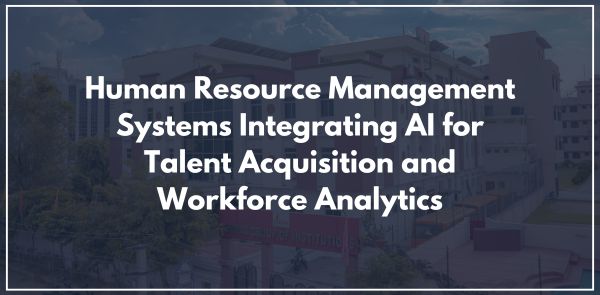Human Resource Management Systems (HRMS) are undergoing a significant transformation with the integration of Artificial Intelligence (AI). This fusion is revolutionizing talent acquisition and workforce analytics, enabling organizations to make data-driven decisions and optimize their human capital. AI-powered HRMS are streamlining processes, improving efficiency, and providing valuable insights that were previously unattainable.
Transforming Talent Acquisition with AI:
Traditional recruitment methods are often time-consuming and prone to bias. AI is addressing these challenges by automating and enhancing various stages of the talent acquisition process:
- AI-Powered Sourcing: AI algorithms can scan online platforms, social media, and professional networks to identify potential candidates with the required skills and experience, significantly expanding the talent pool.
- Automated Screening and Shortlisting: AI-powered resume parsing and analysis tools can quickly sift through large volumes of applications, identifying candidates who best match the job requirements, saving recruiters valuable time.
- Chatbots for Candidate Engagement: AI-powered chatbots can answer candidate queries, provide information about job openings, and schedule interviews, enhancing the candidate experience and streamlining communication.
- Predictive Analytics for Candidate Fit: AI algorithms can analyze candidate data, including resumes, social media profiles, and assessment results, to predict their potential performance and fit within the organization.
- Bias Mitigation: AI tools can be designed to minimize bias in the recruitment process by anonymizing applications and focusing on objective criteria.
- Video Interviews and Analysis: AI can analyze video interview responses, evaluating factors like communication skills, body language, and emotional intelligence.
Leveraging AI for Workforce Analytics:
AI is also transforming workforce analytics, enabling organizations to gain deeper insights into their employees and make data-driven decisions:
- Employee Performance Analysis: AI algorithms can analyze performance data, identify high-performing employees, and predict potential performance issues.
- Employee Turnover Prediction: AI can analyze employee data, such as tenure, performance, and engagement, to predict which employees are likely to leave the organization, enabling proactive retention strategies.
- Skill Gap Analysis: AI can identify skill gaps within the workforce, enabling organizations to develop targeted training and development programs.
- Employee Sentiment Analysis: AI-powered sentiment analysis tools can analyze employee feedback, such as surveys and social media posts, to gauge employee morale and identify areas for improvement.
- Predictive Workforce Planning: AI can forecast future workforce needs based on business trends and employee data, enabling organizations to plan for future staffing requirements.
- Personalized Learning and Development: AI can analyze employee skills and performance data to create personalized learning and development pathways.
Implementation Considerations:
Implementing AI-driven HRMS requires careful planning and consideration of several factors:
- Data Quality and Privacy: AI algorithms require high-quality data to function effectively. Organizations must ensure data accuracy and comply with privacy regulations.
- Algorithm Transparency and Explain ability: It is crucial to understand how AI algorithms make decisions, especially in sensitive areas like hiring and performance evaluation.
- Integration with Existing Systems: AI-powered HRMS must be seamlessly integrated with existing HR systems and workflows.
- Change Management: Implementing AI-driven HRMS requires careful change management to ensure employee adoption and acceptance.
- Ethical Considerations: Organizations must address ethical considerations related to AI, such as bias, fairness, and transparency.
- Continuous Improvement: AI models need to be regularly monitored and updated to maintain their accuracy and relevance.
The integration of AI into HRMS is an ongoing process, with several exciting developments on the horizon:
- Augmented Reality (AR) and Virtual Reality (VR) for Training: AR and VR technologies can be used to create immersive and engaging training experiences.
- AI-Powered Employee Wellbeing: AI can be used to monitor employee wellbeing and provide personalized support.
- Blockchain for Secure Employee Data Management: Blockchain technology can be used to secure employee data and streamline HR processes.
- Increased Natural Language Processing (NLP): NLP will allow systems to better understand and interpret human language in all forms, including text and speech.
By integrating Artificial Intelligence into HRMS, organizations like the Poddar Group of Institutions can revolutionize their talent acquisition and workforce management. AI empowers HR teams to make smarter, data-driven decisions, enhance efficiency, and build a more engaged and future-ready workforce.
